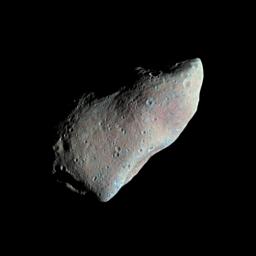Key Takeaways:
Using visible and infrared data collected from telescopes on Hawaii’s Mauna Kea, a team of scientists, led by the University of Maryland’s Jessica Sunshine, has identified three asteroids that appear to be among our solar system’s oldest objects.
Evidence indicates that these ancient asteroids are relatively unchanged since they formed some 4.55 billion years ago and are older than the oldest meteorites ever found on Earth, say Sunshine and colleagues from the City University of New York, the Smithsonian Institution, and the University of Hawaii. Their findings will be published in this week’s edition of Science Express.
“We have identified asteroids that are not represented in our meteorite collection and which date from the earliest periods of the solar system,” says Sunshine, a senior research scientist in the University of Maryland’s department of astronomy. “These asteroids are prime candidates for future space missions that could collect and return samples to Earth providing a more detailed understanding of the solar system’s first few millions of years.”
At the beginning of the solar system, there was just a disk-shaped cloud of hot gas, the solar nebula. When gasses on the edge of the early nebula began to cool, the first materials to condense into solid particles were rich in the elements calcium and aluminum. As the gases cooled further, other materials also began to condense. Eventually the different types of solid particles clumped together to form the common building blocks of comets, asteroids, and planets. Astronomers have thought that at least some of the solar system’s oldest asteroids should be more enriched in calcium and aluminum, but, until the current study, none had been identified.
Meteorites found on Earth do contain small amounts of these earliest condensing materials. As seen in meteorites, these bright white ancient materials, the so-called calcium, aluminum-rich inclusions, or CAIs, can be as large as a centimeter in diameter. Scientists, in fact, long have used the age of CAIs to define the age of the Solar System.
“The fall of the Allende meteorite in 1969 initiated a revolution in the study of the early solar system,” says Tim McCoy, curator of the national meteorite collection at the Smithsonian’s National Museum of Natural History. “It was at that time scientists first recognized that the remarkable white inclusions—later called calcium, aluminum-rich inclusions—which were found in this meteorite, matched many of the properties expected of early solar system condensates.
“I find it amazing that it took us nearly 40 years to collect spectra of these [CAI-rich] objects and that those spectra would now initiate another revolution, pointing us to the asteroids that record this earliest stage in the history of our Solar System,” says McCoy.
Sunshine and McCoy, with colleagues Harold Connolly, Jr, City University of New York; Bobby Bus, Institute for Astronomy, University of Hawaii, Hilo; and Lauren La Croix, Smithsonian Institution, used the SpeX instrument at the NASA Infrared Telescope Facility in Hawaii to look at the surface of asteroids for evidence of the presence of such early bits of high-temperature rock. In particular, they looked for spectral fingerprints indicative of the presence of CAIs. Because different minerals have different reflective properties, the spectrum, or color of light reflected from a surface, reveals information about its composition enabling telescopic compositional analysis.
In their paper, Sunshine and colleagues quantitatively compare the spectral signatures of asteroid surfaces and CAIs in meteorites from the Smithsonian’s National Museum of Natural History collection. “Several CAI-rich asteroids have been identified that contain 2-3 times more CAI material than any known meteorite,” Sunshine says. “Thus it appears ancient asteroids have indeed survived, and we know where they are.”










